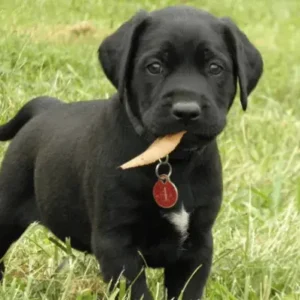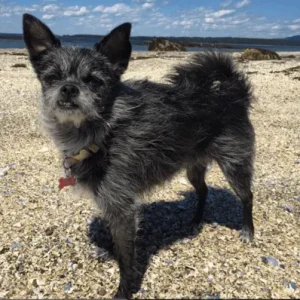Staffordshire Bull Terrier History/Origin
The story of the Staffordshire Bull Terrier is relatively short in canine history but can be confusing due to its many names. Known as the Bull-and-Terrier, Patched Fighting Terrier, Staffordshire Pit-dog, and Brindle Bull, these names show its past.
Staffies are grouped with other “bull types” like the Bull Terrier and American Staffordshire Terrier, sharing a similar background. Centuries ago in England, dog fighting led to the creation of fierce breeds.
The Bulldog, bred for bull-baiting, was mixed with quick terriers to make strong fighting dogs with powerful jaws and fiery spirits. Although blood sports were banned in 1835, secret pit-dog fights continued.
These fights took place in hidden areas where dogs would battle each other or rats. James Hinks of Birmingham perfected the Staffie in the mid-19th century, making it a lasting breed. Named after Staffordshire, where it was popular, the Staffie came to North America in the 1880s.
Staffordshire Bull Terrier is recognized by the American Kennel Club (AKC) under the Terrier Group.
Staffordshire Bull Terrier History- Source: AKC.org
There, breeders developed the taller, heavier American Staffordshire Terrier (AmStaff). Over a century of careful breeding has turned both breeds from fighters into loyal family pets.
AKC Champion Staffordshire Bull Terrier- Source: AKC.org
Staffordshire Bull Terrier Personality
From a young age, Staffordshire Bull Terriers are loving and energetic, always staying alert. Known for their courage, tenacity, and curiosity, they form strong bonds with their families and are attentive to visitors, though they are less likely to guard property.
- Temperament
Staffordshire Bull Terriers are one of the dog breeds known for their affectionate and people-oriented temperament. They are energetic, courageous, and tenacious, displaying a strong will and a curious nature. Despite their tough exterior, Staffies are remarkably loving and form deep bonds with their families.
- Potential Challenges
Staffordshire Bull Terriers, despite their many positive traits, come with some potential challenges. Their strong-willed and determined nature can lead to stubbornness, making consistent training essential from an early age. Without proper socialization, they may develop a tendency to be overly assertive with other dogs, particularly of the same sex.
Their high energy levels require regular physical activity and mental stimulation to prevent boredom, which can lead to destructive behaviors. Additionally, their people-oriented nature means they may struggle with separation anxiety if left alone for long periods. Potential owners should be prepared for the commitment of providing structure, exercise, and consistent guidance to ensure a well-adjusted and happy Staffordshire Bull Terrier.
Staffordshire Bull Terrier Physical Appearance
The Staffordshire Bull Terrier is a sturdy and muscular breed, exuding strength and agility. They have a short, broad head with pronounced cheek muscles and a tight-fitting coat that comes in various colors. Despite their compact size, they are well-proportioned and powerful, showcasing their athletic build.
- Size
Staffords stand 14 to 16 inches tall at the shoulder, with males generally being taller. Male Staffords weigh between 28 to 38 pounds, while females weigh between 24 to 34 pounds.
- Coat color
These purebred dogs features a short, smooth coat that fits closely to the skin. The coat can be red, fawn, white, black, blue, or any of these colors mixed with white, as well as brindle or brindle with white.
Staffordshire Bull Terrier Gender Differences
While there are slight differences in temperament between males and females, a Staffie’s behavior largely depends on how they are raised and socialized as puppies.
The main distinction between the genders is appearance: males are notably larger, with broader skulls and a more muscular build, and they also tend to weigh more.
Staffordshire Bull Terrier Feed/Nutrition
Feed your Staffordshire Bull Terrier 1 5/8 to 2 1/4 cups of high-quality dog food daily, split into two meals.
To prevent gastric dilatation volvulus (bloat), refrain from feeding or giving water for at least an hour after intense exercise. The amount of food your adult dog needs depends on their size, age, body type, metabolism, and activity level.
Dogs, like humans, are individuals, so their nutritional needs vary. A highly active dog will require more food than a less active one. This usually consists of a mix of top-notch protein, beneficial fats, vitamins, minerals, and fiber sourced from vegetables and berries.
Maintain your SBT’s health by measuring their food portions and feeding them twice daily instead of leaving food out continuously. You can also add blueberries as a healthy treat in moderation, ensuring they’re safe and beneficial for your dog.
Staffordshire Bull Terrier Health
Staffordshire Bull Terriers are typically healthy, but like all breeds, they can be prone to certain health conditions. Not every SBT will experience all of these diseases, but it’s crucial to be aware of them if you’re considering this breed. When buying a puppy, choose a reputable breeder who provides health clearances for both parents. These clearances confirm that the dogs have been tested and cleared of specific conditions.
- Hip Dysplasia: Canine Hip Dysplasia is a heritable condition where the thighbone doesn’t fit snugly into the hip joint, leading to discomfort, lameness, or arthritis over time. Regular screening through X-rays by organizations like the Orthopedic Foundation for Animals helps breeders and owners identify affected dogs early and avoid breeding them to prevent passing on this condition.
- Elbow Dysplasia: Elbow Dysplasia results from uneven growth of the elbow’s bones, causing joint laxity and pain, particularly in active dogs like Staffordshire Bull Terriers. Treatment options vary depending on severity, ranging from weight management and medications to surgical interventions aimed at improving the dog’s mobility and comfort.
- Patellar Luxation: Patellar Luxation occurs when the knee cap slips out of place, causing intermittent lameness or discomfort in affected dogs. It can range from mild to severe, with severe cases potentially requiring surgical correction to realign the patella and prevent further joint damage.
- Hereditary Juvenile Cataracts: Hereditary Juvenile Cataracts cause cloudiness in the eye lens, leading to vision impairment and potentially blindness in Staffordshire Bull Terriers as young as three years old. Genetic testing is crucial to identify carriers and affected individuals early, allowing for informed breeding decisions and potential treatment options to preserve vision.
- Skin Allergies: Staffordshire Bull Terriers can develop Atopic Dermatitis, an itchy skin condition often exacerbated by allergens and bacterial infections. Management includes identifying triggers, implementing flea control, and using medications or supplements like omega-3 fatty acids to alleviate symptoms and promote skin health.
- Demodectic Mange: Demodectic Mange, type of mange caused by mites that naturally inhabit a dog’s skin, can become problematic in Staffordshire Bull Terriers with compromised immune systems. While localized cases may resolve on their own, generalized demodectic mange requires veterinary treatment to control symptoms and prevent secondary infections.
Staffordshire Bull Terrier Care and Grooming
The Staffordshire Bull Terrier’s coat sheds minimally throughout the year, with annual shedding that is manageable. Their coat is easy to maintain, as dirt brushes out effortlessly and it dries quickly after baths. Weekly brushing helps remove dead hair, while baths are needed as necessary, thanks to their naturally low odor.
Brushing their teeth two to three times weekly reduces tartar buildup, and regular nail trimming prevents overgrowth that can cause discomfort or snagging on surfaces.
Staffordshire Bull Terriers are highly energetic and require regular exercise to stay healthy and happy. Daily walks, play sessions, and mental stimulation are essential to prevent boredom and channel their energy positively.
Engaging them in activities like agility, fetch, or tug-of-war can also help satisfy their physical and mental needs. Additionally, training your dog to sit is an important basic skill that provides mental stimulation and reinforces good behavior.
Staffordshire Bull Terrier Rescue Groups
Rescue groups dedicated to Staffordshire Bull Terriers are vital in finding homes for needy dogs. These groups often rescue Staffies from shelters or situations where they may face euthanasia due to breed misconceptions. They provide foster care, rehabilitation, and adoption services, ensuring dogs receive proper medical care and behavioral support to thrive in their new home.
Staffordshire Bull Terrier Price
The price of a Staffordshire Bull Terrier typically ranges from $2,000 to $3,000, depending on factors such as breeder reputation, pedigree, and location.
When considering purchasing a Staffordshire Bull Terrier, it’s important to seek reputable breeders who prioritize the health and well-being of their dogs. Responsible breeders provide health clearances and ensure proper socialization of puppies. They often offer support and guidance throughout the dog’s life, ensuring a smooth transition into their new home.
Interesting Facts
- “Stubby,” an AmStaff from Connecticut, earned the rank of sergeant in World War I. He achieved this by capturing a German spy on the battlefield.
Stubby- Source: AKC.org
- Tom Halland has a Staffordshire Bull Terrier named Tessa.
Tessa- Source: Teen Vogue
- They have appeared in the Breed Judging Show 2023.
Best For
Staffordshire Bull Terriers make excellent pets for individuals who are active and enjoy spending time outdoors, as they thrive on regular exercise and play. They are loyal, affectionate dogs that form strong bonds with their families, making them great companions for those seeking a devoted and energetic pet.
Top Names
| Male Staffordshire Bull Terrier Names | Female Staffordshire Bull Terrier Names |
| Max | Bella |
| Rocky | Daisy |
| Tyson | Ruby |
| Diesel | Lola |
| Buster | Rosie |









 Staffordshire Bull Terrier History- Source:
Staffordshire Bull Terrier History- Source:  AKC Champion Staffordshire Bull Terrier- Source:
AKC Champion Staffordshire Bull Terrier- Source: 

 Brindle Staffordshire Bull Terrier- Source:
Brindle Staffordshire Bull Terrier- Source:  Brown and White Staffordshire Bull Terrier- Source:
Brown and White Staffordshire Bull Terrier- Source:  White Staffordshire Bull Terrier- Source:
White Staffordshire Bull Terrier- Source:  Black and White Staffordshire Bull Terrier- Source:
Black and White Staffordshire Bull Terrier- Source: 
 Stubby- Source:
Stubby- Source:  Tessa- Source:
Tessa- Source: 






